
IT Industry Outlook 2019
CompTIA’s annual forecast for the global IT industry provides insight and analysis about 12 key trends that are impacting our lives in business and at home.
A mong the many emerging technologies that companies are exploring to gain a competitive edge, artificial intelligence may be the most enticing thanks to the way that science fiction has inflated expectations. It may also be the most misunderstood thanks to excessive hype from marketers and distinct differences from previous IT models. This research report provides context for the state of AI adoption, describing general perceptions around the concept, current implementation status, and hurdles in the way of future success. Artificial intelligence may be closer than ever, but there are still many steps to take before it is fully integrated into everyday business.
Artificial intelligence represents a new way of thinking about software
Most business—especially on the smaller end of the scale—are not actively developing their own artificial intelligence algorithms. Instead, they are adopting products that have AI features built in. Even so, there must be an understanding of how AI differs from previous software applications. Rather than operating on inputs in a deterministic way to produce results, AI programs take in large amounts of data and work in a probabilistic manner. This means that there is a higher degree of uncertainty in the results. AI may produce unique and disruptive insights, but those insights require some amount of validation.
Innovative use cases require strong foundations
Using a broad definition for AI, many existing IT activities could be placed on an AI spectrum, and building on these activities could lead to better automation or stronger data analysis. However, most companies take a modern view of AI, imagining use cases such as personalized customer experience or security incident detection. Along with the introduction of new AI components, companies must also consider the infrastructure needed, the data that will drive the work, and the processes for integrating AI into workflow.
A mix of basic skills and new skills is needed
From an ownership perspective, 51% of companies say that AI projects are mostly handled by the IT team. Considering the scope of potential impact, businesses should make sure that AI projects are handled similar to most technology projects in a digital organization—as a collaboration between IT and business units. When it comes to detailed implementation, companies are often looking for specific skills around troubleshooting or developing AI, but there are also foundational skills in software development, security, and data management that contribute to AI success.
Strong data management is key to AI operations
Consistent with previous research, very few companies say that they are exactly where they want to be in terms of managing their internal data. The end goal for most AI solutions involves making sense of large amounts of data, so companies face the same challenge in building AI input that they faced in transitioning to a big data strategy. Data silos must be identified, and processes must be built for consistently handling the capture, processing, and visualization of different data streams.
In a new era of digital business, companies are being driven to rethink their approach to technology. There is more focus on using technology strategically, which forces more collaboration between IT and business units. There is a fundamental shift towards a cloud/mobile architecture, which enables more flexibility but also requires new behavior around system management. And there is an acceleration of adoption, which pushes companies closer to the cutting edge of technology innovation.
Being closer to the cutting edge means that businesses need to have a better understanding of which technologies can directly be adopted and which ones are enabling ingredients for more comprehensive solutions. Thinking about the emerging technologies on the landscape today, internet of things is an example of a more direct option. Smart products can be installed and immediately provide some value, even if a more robust strategy might require a more comprehensive plan. On the other hand, artificial intelligence is a technology that many businesses may adopt in an indirect way.
Even trying to define artificial intelligence shows how nebulous the topic can be. At a high level, artificial intelligence is defined as the ability of machines to mimic human intelligence. But that begs the question of what, exactly, characterizes human intelligence? And if this ability is a function of software, how does artificial intelligence differ from other types of software programming?
In reality, the threshold for defining artificial intelligence is constantly shifting. The first enterprise computers mimicked and exceeded the capability of humans to calculate numbers, so that represented the earliest form of artificial intelligence. As hardware and software grew more sophisticated, computers could replicate the ability to consistently arrive at a result based on particular inputs. Think of a computer playing tic-tac-toe, where a finite set of moves can be programmed based on the board configuration.
Today, the common themes for AI are the ability to learn or the ability to make decisions based on a wide variety of inputs. AI is often described as “finding patterns that humans might not see” or “automatically handling tasks based on context.” However, there is a major distinction between these modern tasks and the software functions of the past. What was once deterministic is now probabilistic. We are not asking computers to produce a defined result every time, but to produce an undefined result based on general rules. In other words, we are asking computers to make a guess.
This foundational difference holds massive implications. First and foremost, there must be proper expectations around AI output. Rather than treating the results as completely accurate, there must be some margin of error applied. If AI produces a “best guess” based on all available data, decision makers must consider whether training bias or unknown variables actually led to a poor answer.
Furthermore, the skill set required to develop modern AI is not a simple extension of existing software skills. There are certainly new algorithms to learn, but there are also new concepts around training these algorithms and reverse engineering unexpected results. As much as companies may be adding experience in software development, true AI development requires a new way of thinking. (For more on this topic, see CompTIA’s What is Artificial Intelligence.)
Of course, most companies will not perform their own AI development. Their adoption of AI will come in the form of products that incorporate these new software methods. When considering the sale, implementation, and support of these products, some of the same considerations certainly apply (troubleshooting in particular comes to mind). For the most part, though, AI is not the core piece contributing to a new business solution. A business using AI-enabled CRM will not focus specifically on the AI component, but on the broader sales or customer support processes that will evolve thanks to new capabilities.
It is no surprise to see a wave of products and services with an “AI” label. Businesses are always quick to capitalize on new trends, even if they are fairly loose with defining characteristics. A recent study by the UK investment firm MMC Ventures found that 40% of tech companies describing themselves as AI startups had no evidence of machine learning or other modern AI algorithms in their business model. The label exists to draw investment interest or capture the attention of clients, but it may not be consistent with the innovation that comes from cutting-edge AI practices.
As with any hastily applied label, the truth of the matter is that even if the techniques in play do not classify as state-of-the-art AI, they are still likely to add value to a wide swath of businesses. Since many firms have not been early adopters of technology, they have not kept up to date with practices around software development or data analysis. New approaches in these areas will seem advanced and will open new opportunities.
Regardless of the confusion that exists in this early stage, it is useful to examine perceptions of the new technology and experiences of those companies that believe they are pursuing AI initiatives. These early data point can provide a glimpse into the future direction, allowing IT professionals and firms providing technology services to prepare themselves by building skills or creating new business models.
This report from CompTIA along with the companion piece Practical Insights on AI describe how AI is evolving and exploring the first steps companies are taking as they seek to add AI to their digital business strategy. With disruptive possibilities for both workflow and workforce, AI must be well understood by not only the technology team but also the business executives making decisions on the future of the organization.
The high degree of churn in the AI space does not prevent companies from making revenue predictions, but it does result in a wide range of predictions based on how the impact of AI is being measured. Research consultancy IDC estimates that global spending on cognitive and AI systems will reach $77.6 billion by 2022, growing at an astounding compound annual growth rate (CAGR) of 37.3%. This forecast focuses on the software, hardware, and services that are directly related to AI applications.
On the other end of the spectrum, Gartner makes an attempt to quantify the business value derived from AI systems. In their analysis, AI-driven business value will reach $3.9 trillion in 2022. This value is expected to be achieved across three different areas: customer experience, new revenue, and cost reduction.
These two projected numbers suggest huge benefits along with significant challenges. Clearly, investing on AI has the potential for massive return. But simply purchasing AI systems will not automatically lead to improvements in customer experience or the introduction of new revenue streams. There must be processes in place to connect the new techniques to the expected results, and building these processes can be a major hurdle for firms going through digital transformation.
Adoption trends underscore the challenging nature of bringing AI into a business setting. In late 2017, 24% of companies said that AI was built into their current technology toolset and was being used regularly, and 26% said that there were AI capabilities in their toolset but no regular use. Today, the numbers stand at 29% of companies with regular use and 31% with unused capability. The rapid adoption that some have predicted based on the pace of development or the trends in the consumer space has not materialized. Small companies (less than 100 employees) are the least likely to be using AI regularly; the scarcity of technical resources at these firms means that they will typically be adopting AI as a feature of other products. These products are not as ubiquitous as other technology products yet, and small businesses will also follow a typical product replacement cycle where adoption does not happen instantly.
Measured progress is one marker of difficulty in adoption, but the actual adoption numbers are also likely to be skewed high thanks to the confusion around what constitutes AI. Only 19% of all companies say that they have expert level knowledge around AI, with another 29% classifying their knowledge as moderately high. These levels of understanding are probably a more accurate representation of the number of companies that are performing internal AI development or that are successfully integrating AI techniques into their workflow.
There are a great many words and concepts associated with AI, and these associations show where there are still gaps in understanding. Only 46% of IT and business professionals associate AI with software programs. As described before, the nature of the programming is very different, but AI is still governed by rules and inputs.

Similarly, there is a large difference between those that associate machine learning with AI vs. those that associate neural networks with AI. Both are techniques for building AI systems, but machine learning has gained much more traction as a buzzword.
Finally, the more problematic aspects of AI rank near the bottom. A full appreciation for the ethical considerations, disruptive potential, and cryptic elements of AI will lead to more successful integration with business practices.
The pursuit of emerging technology is not something that can simply be folded in to existing IT operations. To begin with, the shift to a more strategic IT approach is already stretching IT teams in new ways. When cutting-edge technology is added in, the task becomes even more complicated. Many companies use technology products that use established components, making them relatively straightforward to install and support. By definition, emerging technology has components that are in flux. The process of integrating and extracting business value is much more experimental.

For large companies (more than 500 employees) and mid-sized companies (100-499 employees), the discussions might revolve more around priorities or team structure. These organizations have internal employees focused on technology, and so there is more opportunity to redirect those resources.
Small businesses, on the other hand, are less likely to have employees specifically focused on technology. Technology initiatives most often involve tech-savvy workers from business functions. These employees may not have the depth of expertise necessary to resolve early adoption issues related to emerging technology such as AI.
Diving deeper, lack of experience around software development could be another organizational hurdle to understanding the intricacies of AI. Even mid-sized companies have little experience in building custom applications from scratch. The specific needs around software development are in flux and will vary greatly from one company to another, with a strong desire to customize on one hand and the ease of Software as a Service on the other.
Obviously, having an internal software team does not mean that those programmers can be automatically applied to AI initiatives. Two thirds of companies with internal software development skills are applying those skills to AI development, but one third rely on outside tools to introduce AI capabilities.
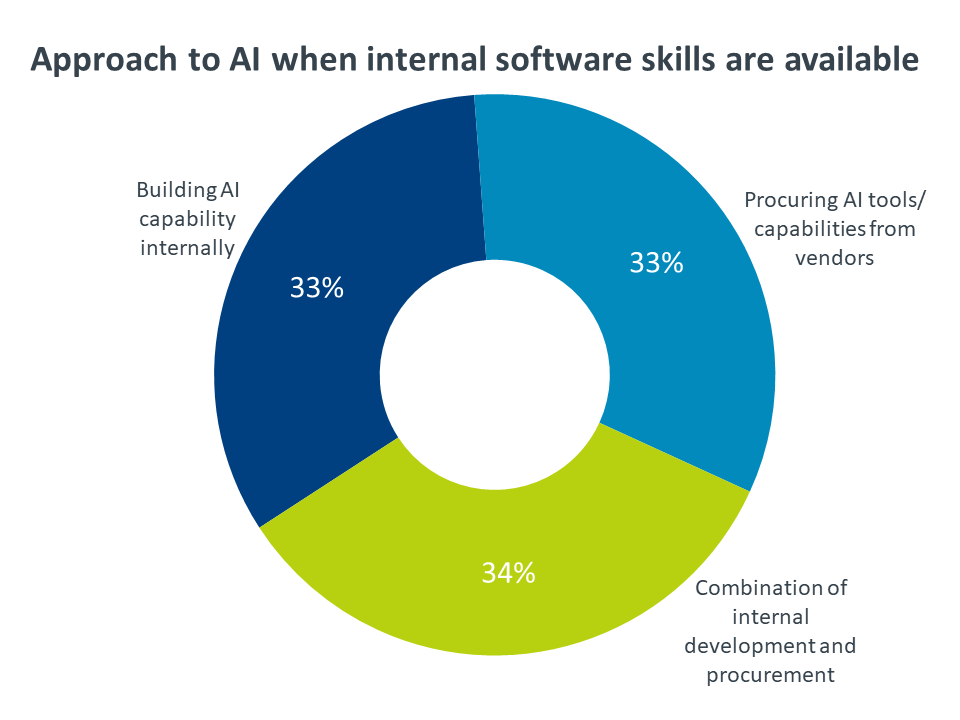
Aside from the availability of technical expertise and the familiarity with software development, the extent to which companies have built a modern architecture is another key ingredient for AI. As businesses accelerate their technology adoption, they need to be sure they are considering the full range of options now available. Emerging technology such as AI or IoT often needs to exist within an architecture containing cloud and mobile components. Furthermore, emerging technologies often work in conjunction with each other to form new solutions. AI in particular will rarely be found in a vacuum, but instead as a piece that enhances and transforms interconnected IT elements.
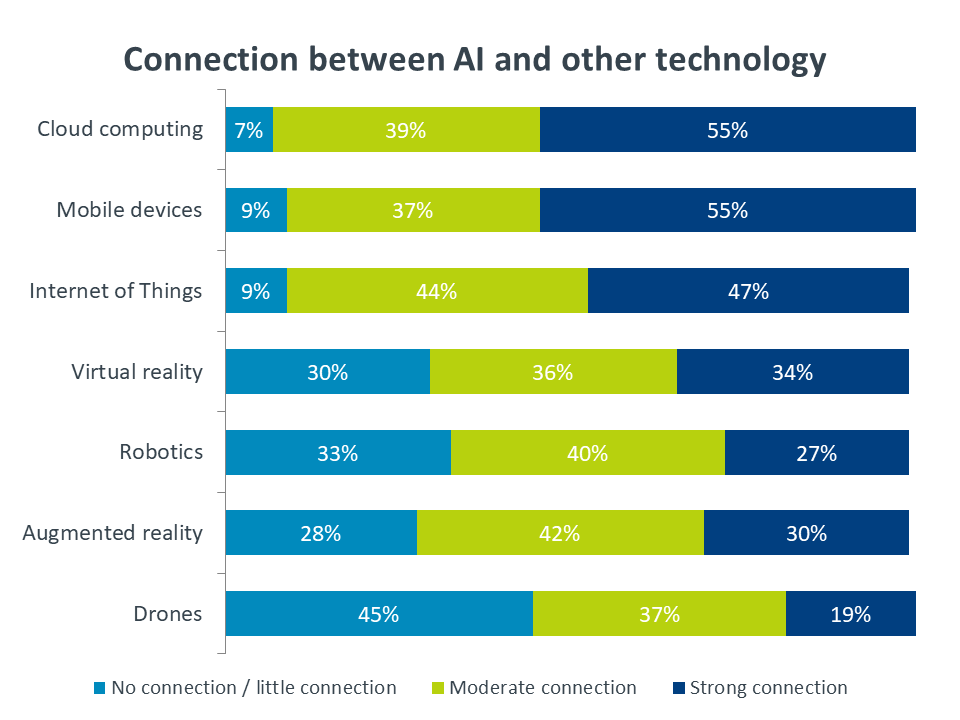
The question of how AI is being used in the enterprise is closely related to the question of what AI is in the first place. Given a fluid definition over the years, many existing IT components could once have been classified as mimicking human intelligence. Presented with a range of enterprise IT situations, less than half of all individuals in the survey felt that existing practices were representative of AI. For example, just 41% felt that the AI label was appropriate for virtual environments that automatically switch in case of failure. Even when the situation was broadened to virtual environments that automatically expand and contract based on workload, only 43% felt that an AI label was appropriate. These examples may be more deterministic than probabilistic, but they still showcase situations where computer algorithms have taken the place of human intervention.
Even some situations that are relying on probabilistic algorithms are not recognized as AI. Auto-complete in email is only labeled AI by 29%, proactive suggestions in a spreadsheet program labeled AI by 25%, and natural language interfaces labeled AI by 23%. These uses of AI may seem more subtle, but they do have the potential to change or improve workflow. The most common IT situations recognized as AI are the ones that most clearly appear to be making human decisions: virtual assistants (55%), robots that can adjust to environmental conditions (55%), and algorithms that adjust network parameters based on traffic observations (51%).

The lack of awareness around existing AI examples is particularly surprising given the places where companies are hoping to use AI in the future. The leading use case is improved workflow, but it seems as though companies are not capitalizing on features of business productivity suites. Handling routine tasks ranks relatively high, but companies may not be focusing on automation techniques that are available.
To be sure, the potential use cases are high-level where the examples are more specific. However, AI is not a single development effort or third-party product that can be brought in to drive an objective. Especially given its nature as a tool that produces results based on probabilities, companies need to carefully consider how AI will integrate with their existing systems, along with the cost of a fully-functioning AI in terms of of supporting hardware and robust datasets (for more on data requirements, see the data section later in this report).
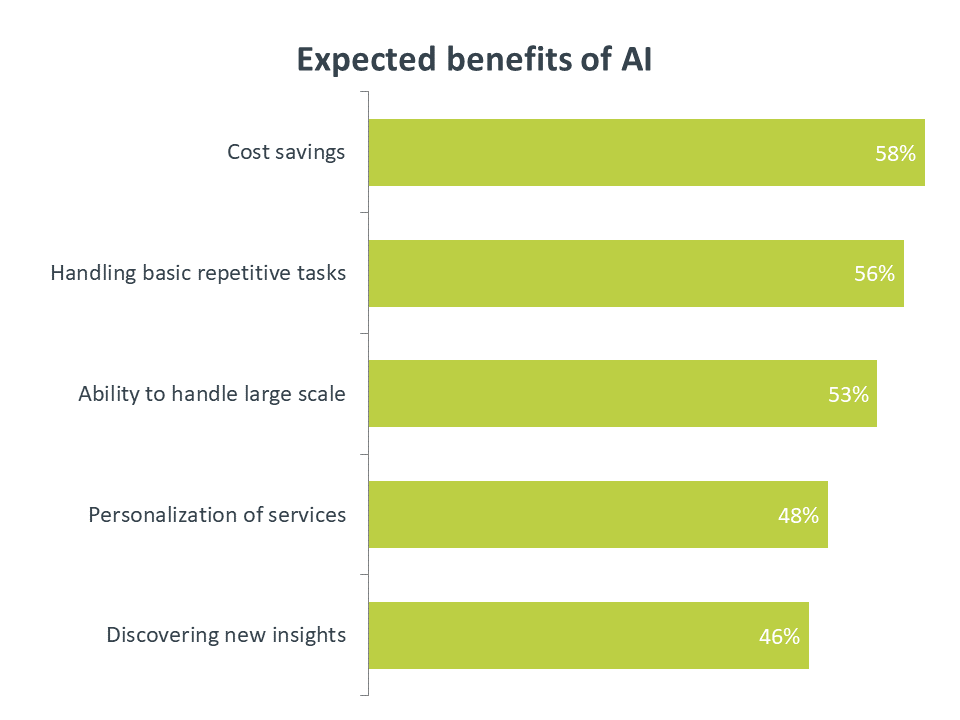
There is also some short-sighted thinking evident in the list of benefits that companies expect to gain from AI and the challenges they expect to encounter. From a benefit perspective, companies are still focused on a traditional IT viewpoint around cutting costs. AI can help with cost savings, but the greater potential lies in opening new doors. Nearly half of all companies are hoping to discover new insights, but these must be factored into a new decision-making process rather than taken as gospel.
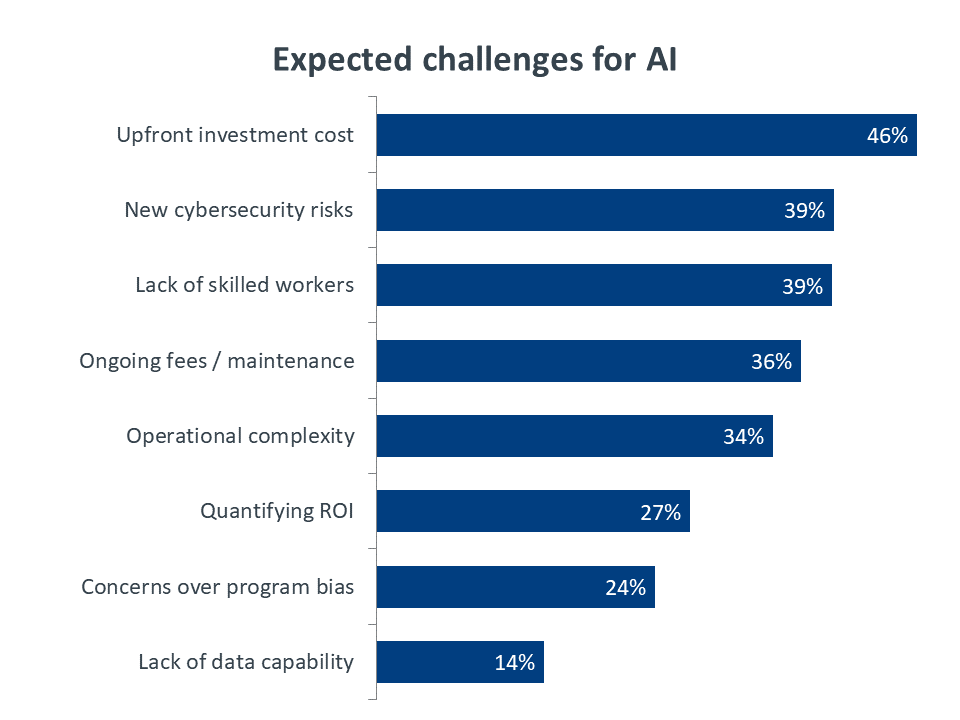
Costs also top the list of challenges that companies expect to face. In early stages of adoption, it is difficult to estimate true costs, and the full picture will likely emerge in the coming years. Cybersecurity concerns have become more prominent with emerging technology, as companies are recognizing that new technology models require new security approaches. Lack of skill, ongoing maintenance, and operational complexity apply not just to AI specifically but also to the foundation required for AI to thrive.
Other challenges, though, are less well understood since they do not fit a typical pattern of technology adoption. Low concern around internal data capabilities indicates low understanding of how data is required for AI. Low concern over programming bias shows that companies are unfamiliar with how AI produces results. And low concern over quantifying ROI shows that few companies are taking an ROI approach that reflects a strategic IT mindset rather than a tactical IT model.
One of the most challenging parts of digital transformation is defining ownership of technology initiatives. CompTIA’s Building Digital Organizations report examined this topic, finding that joint ownership between the IT team and business units is preferable for many activities that involve technology, but some processes like integration and security are best left in the hands of the technical experts.
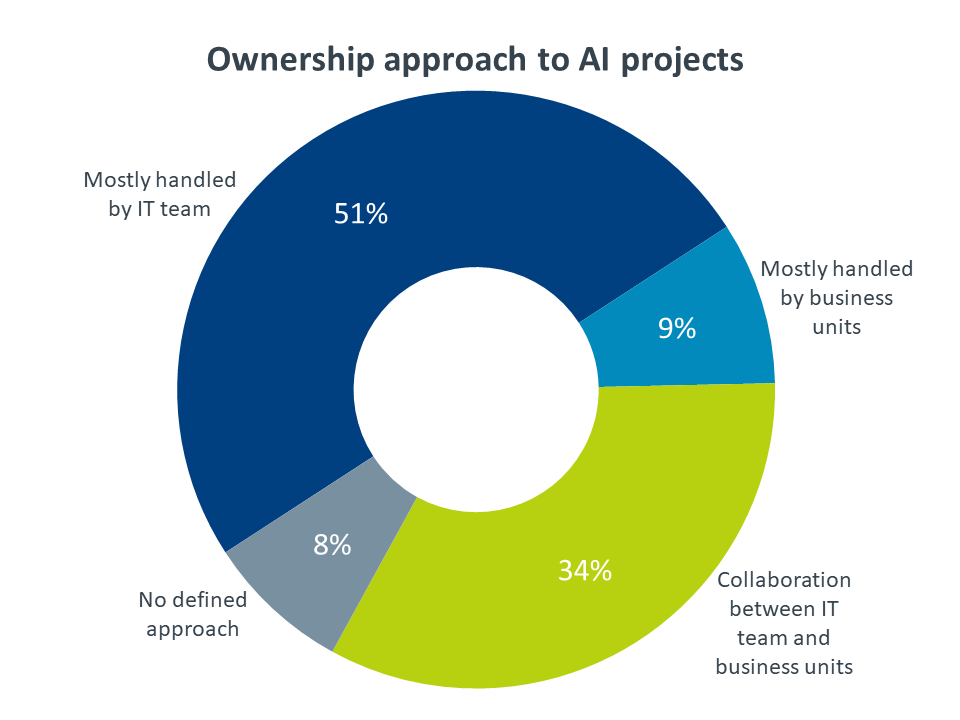
Perhaps because the technology is less understood, AI projects are mostly viewed as the domain of the IT team (whether that team is made up of internal employees or external partners). Companies that are approaching AI as an IT activity should consider the far-reaching implications and move towards a more collaborative model. From the breadth of data used as an input to the potential disruption based on the outputs, AI is a topic that should be discussed by the entire organization.
There is a difference, though, between ownership and implementation. High-level goals and priorities should be decided by a broad group, but the technical details require deeper expertise. The most common resources that businesses expect to use for AI projects are existing technical employees, with 48% of companies planning to leverage this option. As expected, large and mid-sized companies are far more likely to go this route since they have a pool of resources in-house.
The other option is to look on the outside for help. Overall, 38% of companies expect to bring on new headcount for AI work. Similar numbers are expecting to utilize an IT solution provider for AI, whether that solution provider is an existing partner or a new relationship.
At first, it seems somewhat surprising that so many companies would be planning to use their current solution providers for such a disruptive technology, but companies may not necessarily be expecting these existing solution providers to drive innovation. The main area where companies are expecting third party assistance is support and troubleshooting of AI processes troubleshooting of AI processes. Second on the list is procurement of components with AI capabilities. These activities are in line with what companies may be receiving from their current solution provider, but it begs the question of how processes are set up in the first place or how AI-enabled components are integrated into a workflow. Many solution providers are positioning themselves for more innovative work, and there are new firms emerging that specialize in AI enablement, but the end user still needs to understand what they want out of AI and the difficulty in making that happen.
Whether companies are training existing employees, hiring new specialists, or partnering with third party firms, the ultimate goal is building the right skillset. As with other emerging technologies, companies may focus on AI-specific skills without realizing that foundational skills also need to be upgraded. As with solution provider responsibility, the top skill in demand is troubleshooting AI components, followed by AI algorithm development. In order to perform these tasks, though, there must be sufficient skills in software development, security, data management—skills that rank lower on the wish list. Companies should also be focusing on ethical ramifications of AI, given the possibility of AI following training with inherent bias.
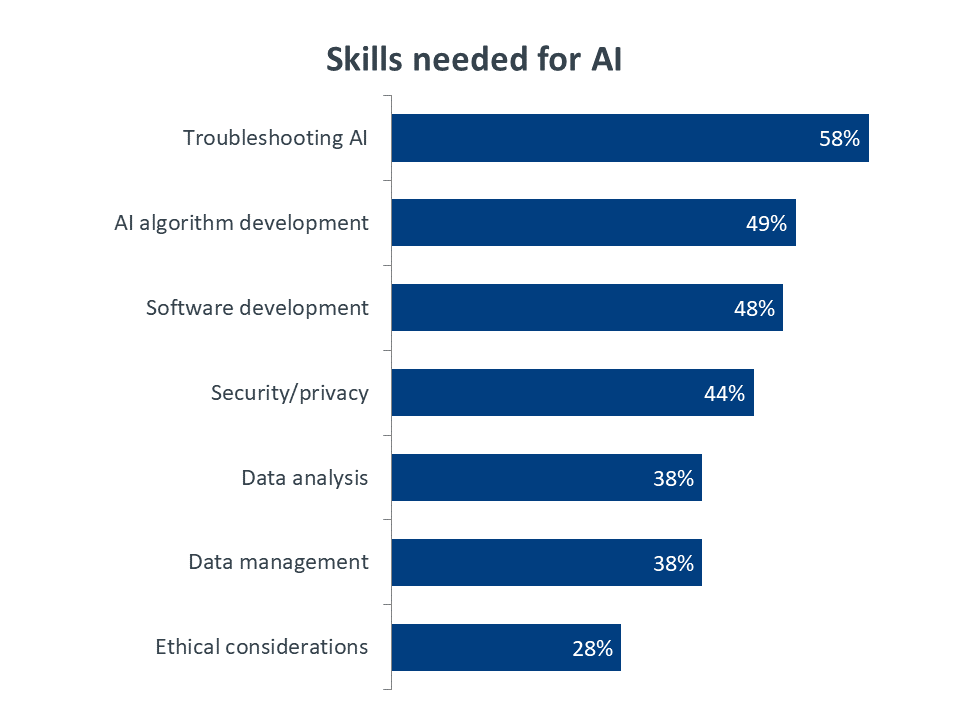
No discussion of AI’s impact on the workforce can ignore the potential for certain tasks or entire roles to be eliminated by new software capabilities. There is constant debate over how AI and other emerging technologies will disrupt the job market. On one hand, there are reports such as a Brooking Institution study claiming that 36 million American hold jobs with high exposure to automation, meaning 70% of their tasks could be performed with current technology. On the other hand, the World Economic Forum claims that there will be a net add of 58 million jobs thanks to AI, with 75 million jobs displaced but 133 million new jobs created. The problem lies in knowing exactly which jobs will be affected and which skills are needed for the new jobs. The net effect may be positive at a macro level, but certain sectors will likely see displacement while others see growth. Establishing transitional training programs, especially considering foundational skills that may be needed, is no small task.
The critical nature of data for functional AI is not immediately obvious. One main reason for this could be that the nature of data in human decision-making is not immediately obvious. Going back to the question of what characterizes human intelligence and how exactly it works, it is easy to overlook the vast amount of data that is used to inform decisions and the ways in which data is absorbed at the time a decision is made.
As with any software, AI requires inputs. However, the inputs for AI differ greatly from inputs for most other software. Rather than using data that is well-defined and highly structured, AI uses broad datasets with variable structure. In addition, this data is needed at two different points: once at the beginning of a process (as with other software), but also during a training phase before the AI program is even able to perform its function.
If the difference between normal software inputs and AI inputs sounds familiar, it is because AI inputs basically fit into the definition of big data. Re-examining the adoption of big data tools and techniques sheds some light on the struggles businesses face as they pursue AI solutions. With big data, companies came to realize that simply adopting new tools was not enough to adequately manage new streams of data. Without a comprehensive plan for gathering, managing, and utilizing existing data, there are significant challenges in shifting to a big data methodology.

With that in mind, organizational data capabilities should be a prime consideration for AI readiness. Very few companies feel that they are exactly where they want to be in terms of how they manage their data. This could mean some degree of dissatisfaction at any stage of the data process, from capturing new data streams to data storage and manipulation to data-driven decision making. The same deficiencies that would have kept companies from fully embracing big data models will be an impediment to AI adoption.

The starting point for building an organizational data plan is simply understanding the full extent of the organization’s data. Over three-fourths of companies recognize that they have data silos, pockets of data specific to a business function that are not visible to data owned by other business units. These data silos limit the abilities of AI, especially in the area of discovering patterns or correlations.
Handling the data silo issue takes on different forms depending on the size of the organization. Only 18% of small companies feel that they have a high degree of data silos. Many of these companies may be so small that their data truly is consolidated, but many others may simply be unaware of where their different data sets reside. Mid-sized companies are the most likely to see a high degree of data silos, with 44% recognizing this to be the case. As they have grown, these businesses have accumulated data sets without always having a plan for how everything works together. The largest companies may have the resources to build and execute a formal data management plan, but 35% still believe there is a high degree of data silos.
Different parts of the organization may also have different awareness around data silos. IT staff typically have a good view of the overall architecture, and 39% of this group sees a high degree of data silos. Executives may understand that they do not have all the data they would want to have for decisions, and 30% of this group sees a high degree of data silos. But business staff may not realize that the data within their unit could be complemented by other data. Only 20% of this group sees a high degree of data silos.
AI is not so much a new tool or product as it is a new concept. Fully understanding this concept and putting it to use requires an appreciation for how AI fits into the overall IT plan. It starts with data, consolidating all corporate information together in order to properly train an AI system and then feed in the appropriate inputs. It extends to the other technology initiatives in a company, so that AI is integrated with existing systems and innovative solutions. The final step is applying AI results to business processes, recognizing that when AI comes close to human intelligence, it is making an educated guess that can still be balanced by workforce expertise.
This quantitative study consisted of an online survey fielded to workforce professionals during March/April 2019. A total of 500 businesses based in the United States participated in the survey, yielding an overall margin of sampling error proxy at 95% confidence of +/- 4.4 percentage points. Sampling error is larger for subgroups of the data.
As with any survey, sampling error is only one source of possible error. While non-sampling error cannot be accurately calculated, precautionary steps were taken in all phases of the survey design, collection and processing of the data to minimize its influence.
CompTIA is responsible for all content and analysis. Any questions regarding the study should be directed to CompTIA Research / Market Intelligence staff at [email protected]. CompTIA is a member of the market research industry’s Insights Association and adheres to its internationally respected code of research standards and ethics.
Read more about Technology Solutions.
Tags : Technology Solutions